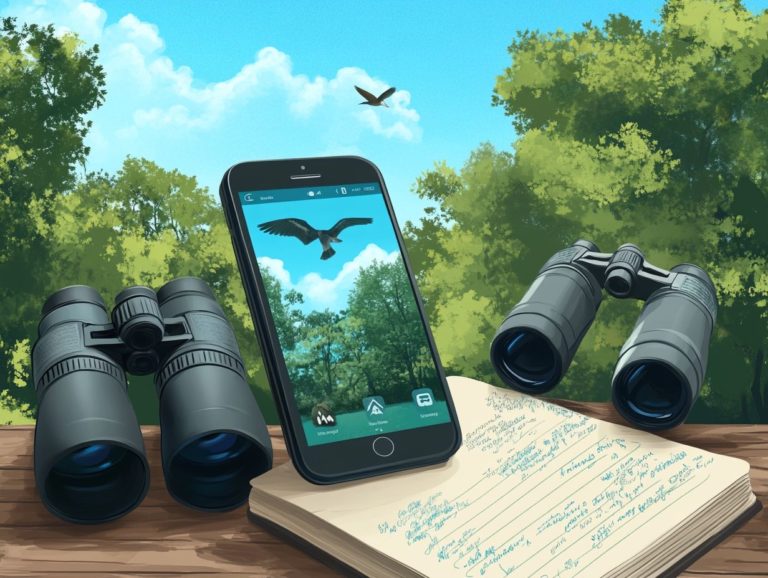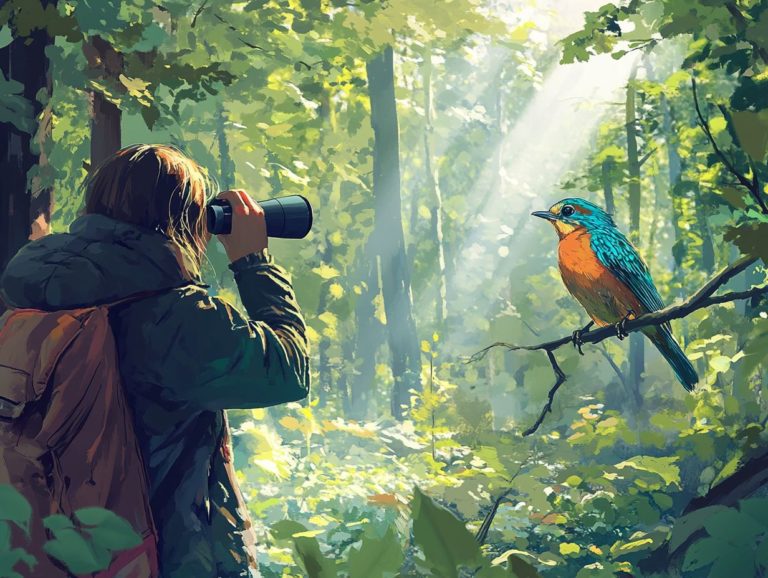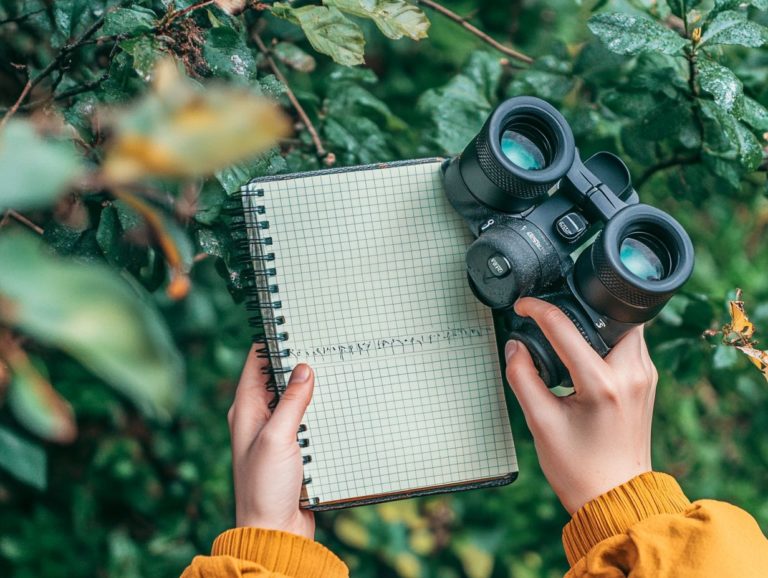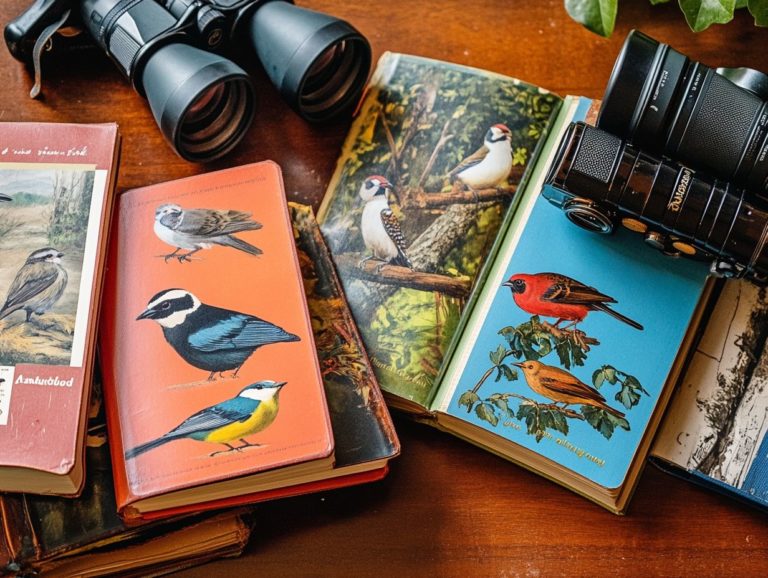How Do I Spot Birds in Densely Forested Areas?
Bird watching in densely forested areas offers a perfect blend of tranquility and excitement. The challenge of spotting camouflaged and elusive birds amidst thick vegetation is rewarding, especially since their songs are often easily heard and identified.
This text explores the benefits of bird watching, the challenges encountered, and the best conditions for successful spotting. It covers essential gear, expert tips, common species to look for, and conservation measures to protect these beautiful creatures, including information on local birding groups.
Contents
- Key Takeaways:
- The Importance of Bird Watching in Densely Forested Areas
- Challenges of Spotting Birds in Dense Forests
- Best Times and Weather for Bird Watching
- Tools and Equipment for Bird Watching
- Techniques for Spotting Birds in Densely Forested Areas
- Common Birds Found in Dense Forests
- Conservation Efforts for Birds in Dense Forests and Urban Areas
- Frequently Asked Questions
- How do I spot birds in densely forested areas?
- What should I bring with me when trying to spot birds in dense forests?
- Is it better to go birding in the early morning or late afternoon in dense forests?
- How can I attract birds to come out of hiding in dense forests?
- What types of birds can I expect to see in densely forested areas?
- Are there any safety precautions I should take when birding in dense forests?
Key Takeaways:
- Bird watching in densely forested areas provides numerous benefits, such as connecting with nature and promoting conservation efforts. Participating in projects where regular people help scientists can also amplify these benefits.
- Spotting birds in dense forests can be challenging, but using the right equipment, techniques, and timing makes it easier.
- Optimal weather conditions and essential gear are crucial for successful birding in these areas.
The Importance of Bird Watching in Densely Forested Areas
Bird watching in dense forests is vital. It helps birders improve how they notice things and fosters a deeper appreciation for nature.
Techniques learned during nature walks enhance understanding of regional fauna, flora, and local wildlife habitats, even in urban areas like Central Park in New York City. Bird watching in these areas raises awareness for bird conservation and encourages stewardship among enthusiasts.
Why Bird Watching is Beneficial
Bird watching is a fantastic way to boost your mental health and serves as a form of nature therapy that reduces stress. It encourages a deeper connection with nature and allows individuals to appreciate the beauty around them.
Watching birds like woodpeckers and bluebirds enhances emotional resilience. The physical activity involved in walking, hiking, or simply standing still while birding improves heart health and boosts overall fitness levels.
Bird watching strengthens the body and nourishes the soul, creating meaningful experiences that deepen one’s connection with nature.
Challenges of Spotting Birds in Dense Forests
Spotting birds in dense forests can be tricky. Identifying different species requires advanced observation skills and a solid understanding of the local environment.
High foliage density, active bird movements, and environmental noise complicate the experience. Bird watchers need patience and adaptability to navigate these challenges effectively.
Obstacles to Overcome
Birdwatching faces visual obstacles like thick foliage and changing light. Noise pollution and bad weather can also lead to missed opportunities for observing rare species.
To tackle these issues, enthusiasts should consider investing in binoculars with image stabilization. A good field guide can assist in identifying various species, and heading out during the early morning hours provides better visibility and quieter environments, as many birds are most active then.
Using apps to identify bird calls can help watchers focus more on sound rather than sight.
Best Times and Weather for Bird Watching
The ideal times and weather conditions for bird watching are those that enhance observation opportunities. Certain conditions increase the likelihood of encountering various species, especially in popular migration hotspots.
Early mornings and late afternoons are generally the best times for bird watching. Calm weather conditions are very favorable, as birds tend to be more active during these periods.
Familiarizing yourself with the best migration spots is an excellent way to enjoy exciting and diverse bird watching experiences.
Optimal Conditions for Spotting Birds
The best conditions for bird watching make every moment exciting! These include favorable weather and times of day when birds are most active, like early morning and late afternoon.
During these times, birds such as kestrels and eagles tend to be more vocal and mobile, searching for food or establishing their territory.
Mild temperatures ranging from 65 to 75 degrees Fahrenheit encourage bird movement, as birds are more likely to leave their nests and forage. Low humidity is also important; many species are more active in drier environments, while high humidity often results in lethargy.
The golden hours of early morning and late afternoon, when the sun is rising or setting, provide softer light that allows for better observation of birds. This gentle illumination avoids glare and minimizes the risk of spooking birds.
Understanding the best conditions for bird watching can significantly enhance your chances of witnessing a diverse array of bird behaviors, from the playful antics of meadowlarks to the elegant movements of loons.
Tools and Equipment for Bird Watching
Essential tools and equipment for bird watching include high-quality binoculars, detailed field guides, and audio guides that help you connect with wildlife by identifying birds by their songs. This allows for a richer birding experience.
Essential Gear for Successful Birding
The three essential items for birding are binoculars for close observation, a field guide for identification, and bird feeders to attract various species such as ducks, geese, and swans to your backyard.
These tools are crucial for enhancing your appreciation of bird life, as they enable you to spot not only the birds themselves but also learn about their behaviors and habitats.
A pair of binoculars is fundamental, providing the significant advantage of allowing you to zoom in with clarity on birds that are farther away. While binoculars are excellent for up-close observation, a good field guide helps in spotting and identifying different species based on their markings, sounds, and wing patterns.
When placed in suitable locations, bird feeders can create a lively atmosphere by attracting local birds, making observation easier. To ensure your birding gear lasts longer, store binoculars in a protective case and clean their lenses regularly. Keep field guides safe in backpacks to maintain their condition.
By following these practices, you not only enrich your birding experience but also enhance your efficiency in the field.
Techniques for Spotting Birds in Densely Forested Areas
Bird identification techniques in dense forests require careful observation, silence, and patience. These skills allow bird watchers to recognize various species, such as hawks and gulls, even in challenging conditions.
Expert Tips and Tricks
To enhance your bird-watching experience, consider the following expert tips:
- Improve your observation skills through practice.
- Use stealth to minimize disturbances.
- Cultivate patience to increase your chances of spotting rare species.
Mastering the art of moving soundlessly significantly enhances your experience. Being mindful of your own shadows and utilizing natural cover like bushes and trees can dramatically improve your chances of an encounter.
Spending time in areas rich with bird songs not only helps in identifying different species but also enriches the overall experience. The gentle sounds of chirps and calls can guide watchers toward hidden nests and feeding grounds, enabling interactions with wildlife that many may not have anticipated.
Get out there and enjoy the thrill of bird watching!
Common Birds Found in Dense Forests
Dense forests are home to a variety of common birds, including woodpeckers, ravens, bluebirds, and various raptors such as hawks and eagles.
Each of these species possesses distinctive characteristics that can be identified through careful observation.
Identifying and Attracting Different Species
To effectively identify and attract various bird species, it is essential to understand their behaviors and preferred habitats.
Using bird feeders can draw in ravens and other wildlife. Observing birds’ feeding and vocal habits will help attract and identify them more easily.
By placing bird feeders filled with seeds that appeal to different types of birds, such as finches and titmice, you can attract a wide variety of species to your yard.
Familiarizing yourself with the songs and calls of different species will enhance your ability to identify them and determine their presence, even when they are not visible.
This knowledge, combined with an understanding of seasonal changes and migration patterns, will enrich the experiences of both novice and seasoned birdwatchers.
Areas like Central Park, where diverse environments are accessible, are particularly rewarding for birdwatching enthusiasts.
Conservation Efforts for Birds in Dense Forests and Urban Areas
Conserving birds in forested areas plays a crucial role in maintaining biodiversity and protecting vital wildlife habitats.
This effort ensures that diverse populations of birds can thrive in their natural environments.
How to Support and Protect Bird Populations through Citizen Science
You can make a real impact by supporting and protecting bird populations!
Get involved in your community by joining local birding groups and participating in habitat protection projects.
Connecting with fellow bird enthusiasts allows individuals to deepen their knowledge and appreciation for birds.
Many local birding groups organize regular outings, workshops, and educational lectures that raise awareness about various bird species and their significance to ecosystems.
Habitat protection projects can be supported through monetary donations or volunteer efforts aimed at restoring environments where these birds thrive.
Citizens can also participate in citizen science projects, such as bird counts or monitoring programs, which provide essential data for research and conservation efforts.
This involvement enhances the likelihood of protecting these beautiful creatures for future generations.
Frequently Asked Questions
How do I spot birds in densely forested areas?
To spot birds in densely forested areas, it’s important to know their habits and behaviors. Look for areas with dense vegetation and listen for bird calls or songs.
Use binoculars to scan the branches and foliage for movement or flashes of color.
What should I bring with me when trying to spot birds in dense forests?
It’s recommended to bring binoculars, a field guide, and a notebook to record your sightings.
Also, wear appropriate clothing and footwear for hiking through the forest.
Is it better to go birding in the early morning or late afternoon in dense forests?
Early mornings tend to be the best time to spot birds in dense forests as they are most active during this time.
However, late afternoons can also be good, as birds may be out foraging for food before settling down for the night.
How can I attract birds to come out of hiding in dense forests?
Using bird calls or songs can help attract birds out of hiding, as they may respond to the calls and come out to investigate.
You can also try leaving out bird feeders or scattering bird seed on the ground to entice them.
What types of birds can I expect to see in densely forested areas?
The types of birds you can expect to see will vary depending on your location and the type of forest.
However, some common birds found in dense forests include woodpeckers, warblers, thrushes, and various species of owls.
Are there any safety precautions I should take when birding in dense forests?
Yes, it’s important to be aware of your surroundings and watch out for potential hazards such as slippery rocks or branches.
It’s also a good idea to let someone know where you’ll be birding and to have a map or GPS device with you in case you get lost.




